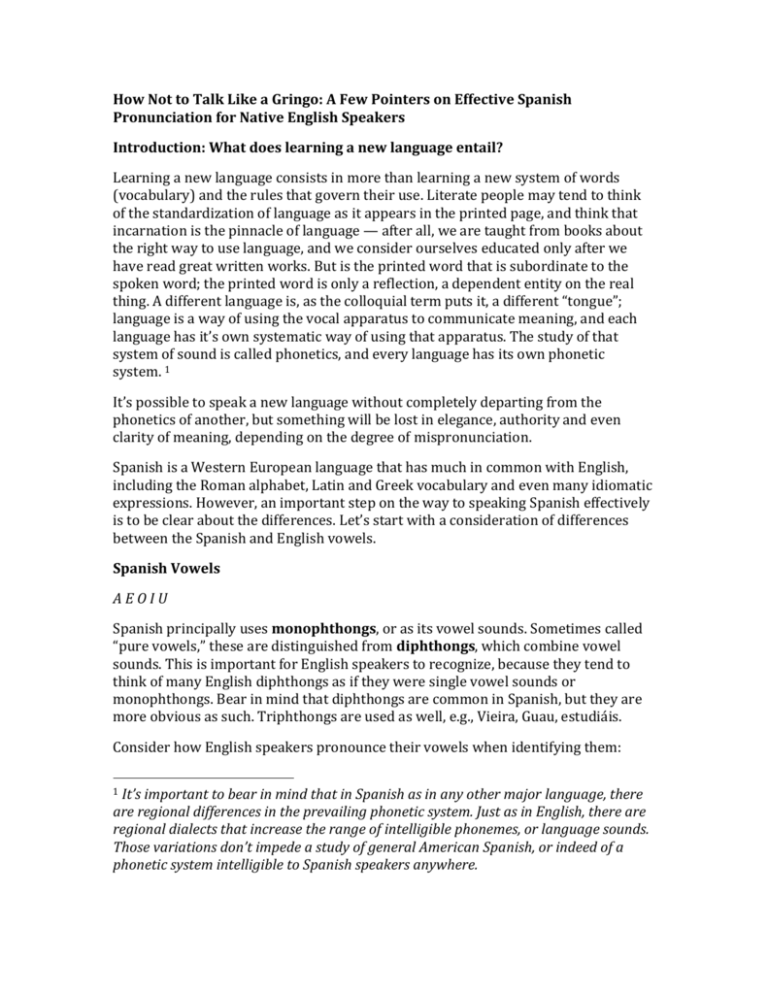How Not to Talk Like a Gringo: A Few Pointers on Effective Spanish
advertisement

How Not to Talk Like a Gringo: A Few Pointers on Effective Spanish Pronunciation for Native English Speakers Introduction: What does learning a new language entail? Learning a new language consists in more than learning a new system of words (vocabulary) and the rules that govern their use. Literate people may tend to think of the standardization of language as it appears in the printed page, and think that incarnation is the pinnacle of language — after all, we are taught from books about the right way to use language, and we consider ourselves educated only after we have read great written works. But is the printed word that is subordinate to the spoken word; the printed word is only a reflection, a dependent entity on the real thing. A different language is, as the colloquial term puts it, a different “tongue”; language is a way of using the vocal apparatus to communicate meaning, and each language has it’s own systematic way of using that apparatus. The study of that system of sound is called phonetics, and every language has its own phonetic system. 1 It’s possible to speak a new language without completely departing from the phonetics of another, but something will be lost in elegance, authority and even clarity of meaning, depending on the degree of mispronunciation. Spanish is a Western European language that has much in common with English, including the Roman alphabet, Latin and Greek vocabulary and even many idiomatic expressions. However, an important step on the way to speaking Spanish effectively is to be clear about the differences. Let’s start with a consideration of differences between the Spanish and English vowels. Spanish Vowels AEOIU Spanish principally uses monophthongs, or as its vowel sounds. Sometimes called “pure vowels,” these are distinguished from diphthongs, which combine vowel sounds. This is important for English speakers to recognize, because they tend to think of many English diphthongs as if they were single vowel sounds or monophthongs. Bear in mind that diphthongs are common in Spanish, but they are more obvious as such. Triphthongs are used as well, e.g., Vieira, Guau, estudiáis. Consider how English speakers pronounce their vowels when identifying them: It’s important to bear in mind that in Spanish as in any other major language, there are regional differences in the prevailing phonetic system. Just as in English, there are regional dialects that increase the range of intelligible phonemes, or language sounds. Those variations don’t impede a study of general American Spanish, or indeed of a phonetic system intelligible to Spanish speakers anywhere. 1 A, E, I, O, U — with the exception of “E,” they are pronounced as diphthongs composed of monophthongs more or less equivalent to the Spanish vowels: ei, i, ai, ou, iu English speakers are so accustomed to thinking of these vowels as single sounds, that they have to work at avoiding pronouncing Spanish vowels as diphthongs. Also important to recognize is that in written language, unlike in English, the pronunciation of Spanish vowels is unaffected by the letters surrounding the vowel. For example, a final “e” after a single consonant in English “lengthens” the vowel. There is no such phenomenon in Spanish. English speakers must take care to give Spanish vowels their full value because of their tendency to neutralize (using the “schwa” sound) or omit vowel sounds on unstressed syllables. Take, for example, a word common to Spanish and English: chocolate. An approximation of the English pronunciation might be as follows: CHO-kuh-luht (American English speakers tend to go even further, omitting the second syllable all together: CHA-kluht) In Spanish, there is no muting or neutralization of the vowels: cho-ko-LA-te This neutralizing tendency, along with the diphthong habit, could lead to English speakers to mispronounce chocolate as cha-kuh-LA-tei, or phrases such as “conflictos económicos” as: Kuhn-FLIHK-tous-e-cuhn-OH-muh-cous instead of: con-FLIK-tos-e-co-NOM-i-cos It might be helpful to show a spelling that better suggests the full Spanish pronunciation: Confleektos económeekos Notice that the spelling is funny in a way because it emphasizes the differences in the way Spanish and English language natives speak. The latter need to focus on these differences, always bear them in mind when practicing pronunciation, and fight deliberately against their English-conditioned habits of pronunciation. Consonants Most Spanish consonants resemble those in English and present less occasion for serious mispronunciation on the part of the speaker and misunderstanding on the part of the listener. However, learning to recognize the difference between consonants in the two languages will improve the pronunciation and, consequently, the authority with which you speak Spanish. /z/ In general American Spanish, the /z/ is an unvoiced sibilant, in other words, it’s always the equivalent of the English /s/, never the English /z/. Peninsular Spanish pronounces the /z/ like the English /th/.2 /r/ — This is not one of the most difficult consonants for English speakers, but there is a tendency to use the English lingua-palatal /r/ instead of the alveolar tap, similar to a /d/ between vowels. Just keep in mind that the retroflex r doesn’t exist in Spanish. (The same applies to the uvular r, such as is used in Austrian German, for example.) /rr/ — This sound, the alveolar trill /rr/, is one of the most difficult sounds for most American English speakers. Try stopping the other r sound in motion, then practice by trying to vibrate your tongue by passing a stream of breath past it. After a while, you’ll find you’re able to do this much better with your tongue quite relaxed. /t/,/p/,/k/, hard /c/ – English speakers aspirate these consonants, i.e., they expel air before they begin to vocalize the following vowel. Since Spanish speakers don’t do this (or do it less), these unvoiced consonants sound in Spanish more like voiced consonants: /t /sounds like /d/, /k/ like /g/, /p/ like /b/. However, Spanish voiced and unvoiced consonants can still be distinguished from each other (a /t/ is not the same as /d/; a /c/ is not the same as a /g/. /b/ and /v/ — These are pronounced the same, like an English /b/. /d/ — A little thicker or “wetter” than the English /d/, the Spanish one touches the bottom of the teeth rather than the top. /j/ — Pronounced similarly to an English /h/ but with some palatal friction. Never pronounced like an English /j/ or /y/. /g/ — Pronounced more or less like an English /g/ unless before an /i/ or /e/, in which case it functions like the Spanish /j/, like an English /h/ but with some palatal friction. How to Practice: Learning new phonology is like learning a new musical instrument. Native speakers of any language are virtuosos: they effortlessly careen through phonetic subtleties that would terrify a novice to their language. However, trying to speak Spanish with The voiced sibilant — the English /z/ sound — does occur as a variant in some regional accents, especially after a vowel and before a consonant, e.g., mismo as “mizmo.” 2 your English “chops” is like trying to play guitar with piano technique. The result is bound to be halting and unmusical. Practice pronunciation by reading aloud. You must read very, very slowly, and with utter intolerance for English phonological speech habits. Remember that you’re learning a new tongue — don’t’ speak with the old one. Plod on, deliberately, savoring each syllable in its full Spanish glory. Exaggerate the different ways Spanish requires you to use your vocal apparatus — you can speak in a more subtle way this once you’ve retrained your vocal chamber to the new phonetic system. Pick out a few words that are especially difficult, perhaps some long ones or ones with difficult sounds (e.g., ferrocarril). Even if you already have a decent accent when Speaking, you may need to slow down to achieve a something closer to native articulation. Like a good musician, you can speed up as you gain control and move closer to perfection. Review • Recognize that Spanish vowels are monophthongs • Don’t mistake Spanish monophthongs for English diphthongs • Always give Spanish vowels their full value, avoiding the English speaker’s habit of neutralizing vowels • Practice by reading aloud, slowly and intolerantly of English phonetic interference. Speed up only as you master a purely Spanish phonetic pronunciation.








